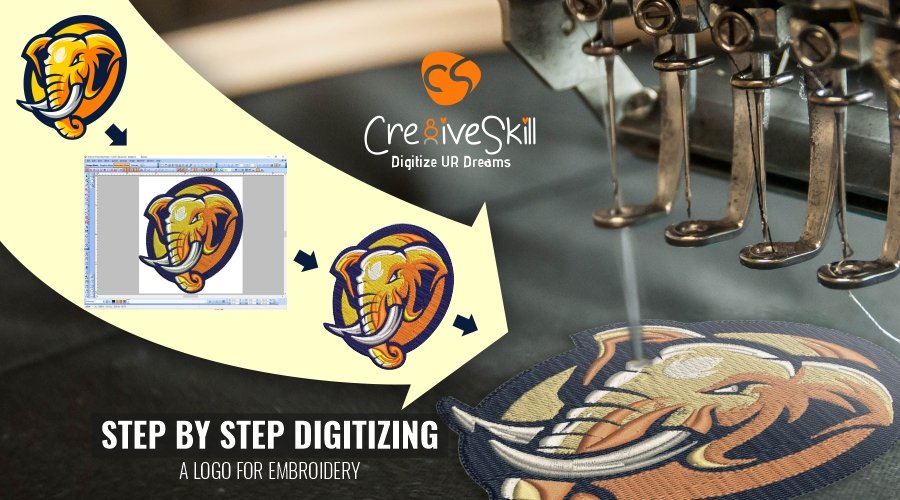Streamlining the Art of Needlework Digitizing: Step-by-Step Guide
Needlework digitizing is a meticulous craft that demands precision and imagination. As modern technology remains to advancement, the digitization procedure has come to be extra available, permitting fanatics to bring their intricate styles to life effortlessly. In this overview, we will untangle the intricacies of embroidery digitizing, breaking down each step methodically to simplify the procedure and encourage both beginners and seasoned embroiderers alike. Remain tuned to find just how you can streamline this detailed art kind and change your imaginative visions into magnificently stitched masterpieces.
Comprehending Needlework Digitizing Software Program
Needlework digitizing software program offers as a crucial tool for transforming detailed designs right into digital layouts compatible with embroidery machines, helping with exact sewing and personalization. This specialized software application allows customers to import different picture documents layouts, such as JPG or PNG, and transform them right into embroidery machine-readable styles like DST, EXP, or PES - Digitizing for Embroidery. By making use of features like stitch editing, padding alternatives, and string color choice, digitizing software application enables individuals to manage every facet of the design process
Additionally, advanced embroidery digitizing software application uses devices for creating intricate designs, readjusting stitch thickness, and integrating elaborate details. Customers can also preview the layout before stitching it out, making sure precision and lessening errors. Furthermore, several software programs give automatic attributes that assist improve the digitizing process, saving time and effort.
Understanding the capacities of embroidery digitizing software program is essential for attaining high-grade lead to embroidery projects. By understanding this device, embroidery enthusiasts and specialists can unleash their imagination and bring intricate styles to life with accuracy and performance.

Choosing the Right Style Documents
After familiarizing yourself with the capacities of embroidery digitizing software, the next important action in the procedure is choosing the appropriate design declare your job. Digitizing for Embroidery. When selecting a design declare embroidery digitizing, it's vital to take into consideration the complexity of the design, the size of the end product, and the kind of material you will certainly be collaborating with
For complex styles with fine information, a high-resolution image or vector documents is advised to make certain that the needlework machine can precisely replicate the style. Additionally, the size of the end product plays a considerable role in selecting the right style data. Larger styles may call for higher resolution documents to keep quality and sharpness.
Moreover, the type of textile you will be embroidering on affects the selection of layout data. Different textiles might need modifications in the design data to guarantee that the stitches are correctly straightened and the layout shows up Going Here as planned. By very carefully picking the right layout data based on these elements, you can set on your own up for a successful needlework digitizing procedure.
Digitizing Tools and Methods
Utilizing specialized software application and accuracy techniques, digitizing tools are necessary in transforming detailed designs right into embroidery-ready data. Needlework digitizing software, such as Wilcom, Hatch, or Embrilliance, provides the needed system to convert artwork into stitch data. These programs provide features like stitch editing and enhancing, underlay alternatives, and text devices to make certain the design equates effortlessly onto textile.
Among the key strategies in digitizing is creating a clear path for the needlework maker to follow. This entails digitizing each component of the layout with accuracy, identifying stitch kinds, thickness, and instructions. By utilizing tools like digitizing tablets or software-specific plugins, embroiderers can accomplish a high level of precision in their digitized designs.
Additionally, understanding the art of underlay stitching is critical for creating high quality needlework. Underlay sewing maintains the material and develops a structure for the layout, ensuring that the browse around this web-site last product is both aesthetically attractive and lasting. By recognizing these digitizing tools and techniques, embroiderers can boost their craft and bring complex designs to life with accuracy and performance.
Personalizing Stitch Types and Directions
Having established a structure in digitizing devices and methods, a crucial aspect ahead of time embroidery workmanship lies in customizing stitch kinds and directions with precision and function. The option of stitch types can significantly affect the general appearance and appearance of the embroidered style. Satin stitches, recognized for their smooth and glossy finish, job well for developing borders and text. On the other hand, fill stitches are ideal for covering bigger areas efficiently. By tactically combining these stitch types, embroiderers can achieve depth and dimension in their layouts.
Additionally, the instructions of stitches plays an essential function in boosting the visual appeal of the final needlework. By exploring with different stitch angles and patterns, embroiderers can bring their layouts to life with exceptional detail and intricacy.
Screening and Refining Your Digitized Design
To ensure the precision and top quality of your digitized design, complete screening and refinement are crucial steps in the embroidery digitizing process. Once you have finished the digitization of your layout, it is vital to check it before continuing with the real needlework. Checking enables you to identify any possible concerns such as thread breaks, stitch thickness troubles, or layout distortions that may influence the result.

After testing, internet it is necessary to fine-tune your digitized design based upon the comments from the examination sew-out. This might entail tweaking stitch settings, adjusting densities, or making modifications to the overall style to achieve the preferred end result. By repeating through testing and improvement, you can fine-tune your digitized style to excellence before relocating forward with the real embroidery procedure.
Verdict
To conclude, understanding the art of needlework digitizing requires an extensive understanding of the software program, selecting the appropriate layout file, utilizing digitizing tools and strategies, personalizing stitch types and instructions, and screening and improving the digitized layout. By adhering to these steps, embroiderers can streamline the digitizing procedure and create high-quality stitched designs with precision and efficiency.
Comments on “Top Quality Digitizing for Embroidery: Specialist Workmanship”